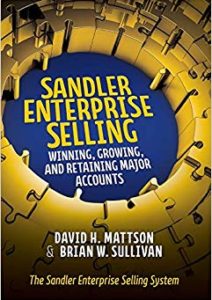Winning business with a major account is a significant achievement that brings new revenue and profit. But with enterprise accounts, the win is just the beginning.
In a recent Sandler Research Center survey, the topic of client retention deservedly received significant attention. In the survey, sales respondents worldwide were asked, “What percentage of your sales team’s time is dedicated to client retention versus pursuing new business?”. The intriguing results showed that 53% of those responding spent the majority of their selling time pursuing new clients. After all the time and effort spent in winning a new major account, the research shows that most selling teams head for the hills in search of new treasures. But what about the treasures in the major account that they’ve just won?
Enterprise pursuits can be long, challenging and costly. But for effective selling organizations, the payoff of winning is huge. For major accounts are ecosystems of growth and with the business won, your ability to deliver with excellence sets the stage for expansion – for hunting and finding those internal treasures.
How do you make it happen? First, by focusing on the teaming of sales and delivery. The dreaded hand-off is simply unworkable with enterprise accounts. Just as engaging delivery team members in pursuits increases the chances of winning, the continued involvement of sales with delivery drives growth. This continuous process of teaming seeds long-term account relationships. That’s the enterprise world.
With delivery excellence in place, having a growth framework to follow is critical. The Sandler Enterprise Selling Client2 Tool provides the practical guide, charting the five paths to account expansion – Organic Growth, Partnerships and Alliances, Family Tree, Alumni and Customer’s Customer. Truthfully, it’s the treasure map to account growth.
Organic Growth, of course, is a path followed by many selling teams and often very effectively. Not always, though, as organizations that divert their sales teams after contract signing struggle mightily with even this fundamental channel, which covers the extension or renewal of a current engagement and its potential expansion into other departments. Also explored here is selling additional offerings from your portfolio to the many areas in the organization. In short, Organic Growth is going deep and wide in both the account and in your product/service portfolio.
The next channel is Partnerships and Alliances. In winning enterprise deals, you often partner with firms whose capabilities enhance your solution. Additionally, while delivering for a major account, you likely connect with other firms doing the same. Whether co-bidding or co-delivering, these natural alignments create fertile opportunities. But you must work proactively to grow these connections into mutual victories through collaborative planning – for and with your partners.
Then, the Family Tree channel exploits the ecosystems of opportunity in enterprise accounts’ extended networks. Parents, subsidiaries and sister companies are all potentially fruitful targets, with your successful delivery track record as the springboard to those connected entities. Think about it. If you’re serving Geico, the insurer, why might you have possible opportunities with Fruit of the Loom, the apparel firm? Or Net Jets, the aviation leasing firm or Dairy Queen, the ice cream chain? Why? Because they’re all Berkshire-Hathaway companies – family members, if you will. Of course, there’s no guarantee that Dairy Queen would beg you to sell to them simply because Geico is your client. Of course not. But the connection adds verifiable warmth and credibility to the contact – a very promising start.
In enterprise accounts, decision-makers come and go. The Client2 Alumni channel helps you track those exiting, potentially opening new doors where they land. And once you’ve proven your organization’s capabilities to the new client contacts who take their places, how about seeking their guidance and referrals into their ex-employers? Sure, it takes work. But again, adding a level of warmth to cold contacts chips away much of the ice.
Last is Customer’s Customer. In serving enterprise accounts, you often interact directly with their clients, the end customers who directly benefit from your services. What about potentially having these firms already familiar with the quality of your work as your clients as well?
Of course, common sense must dictate your strategy and actions. You never randomly reach out to your client’s contacts without being respectful and communicative. Be smart and open, though, and odds are your client will be supportive, often very directly.
In the end, your mindset must be that account growth is your obligation. Why? Because you owe it to yourself and your organization given the tangible benefits it delivers to you both. But most importantly, you owe it to your clients, who decided to invest in you as their partner. For you to neglect seeking every possible way to deliver additional value would be doing them a great disservice. So, internalize that mindset, follow the framework and grow!













Comments